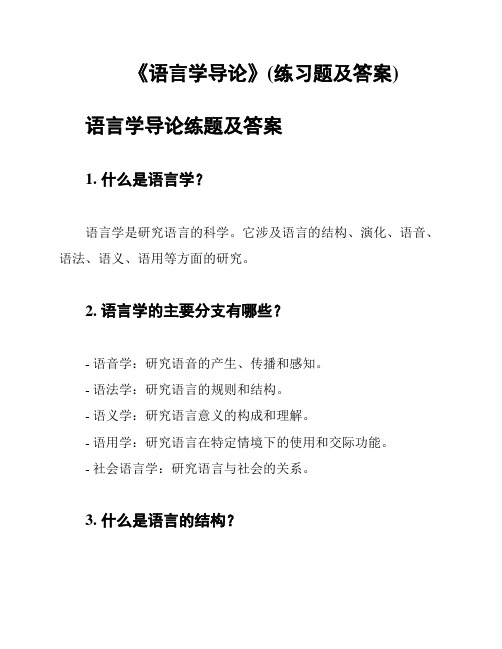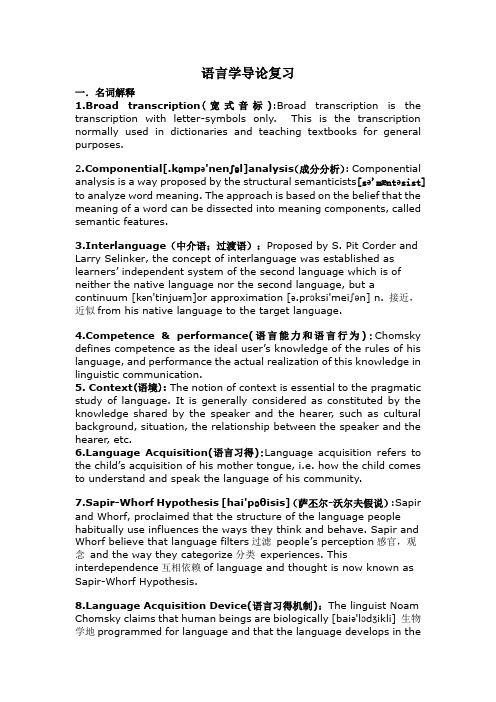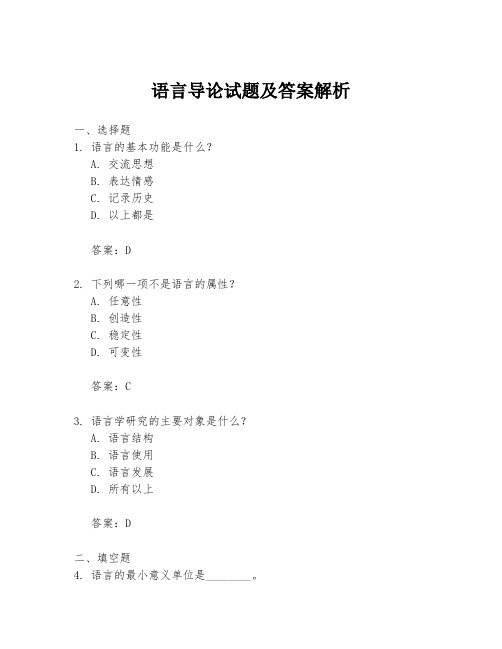2015 语言学导论练习题
- 格式:docx
- 大小:19.23 KB
- 文档页数:4

语言导论试题及答案一、单选题(每题2分,共20分)1. 语言导论中,语言的最小意义单位是:A. 音素B. 词C. 短语D. 句子答案:A2. 下列哪项不是语言的社会功能?A. 信息传递B. 文化传承C. 情感表达D. 个人娱乐答案:D3. 语言的任意性是指:A. 语言符号与其所指对象之间没有必然联系B. 语言符号与其所指对象之间有必然联系C. 语言符号与其所指对象之间有逻辑关系D. 语言符号与其所指对象之间有物理关系答案:A4. 语言的双重性是指:A. 语言的任意性和线性B. 语言的任意性和系统性C. 语言的线性和社会性D. 语言的系统性和社会性答案:A5. 语言的线性是指:A. 语言符号的排列顺序B. 语言符号的排列顺序和组合方式C. 语言符号的排列顺序和意义D. 语言符号的排列顺序和语法规则答案:B6. 语言的系统性是指:A. 语言符号的任意性B. 语言符号的线性C. 语言符号的组合方式D. 语言符号的内部结构和规则答案:D7. 语言的变异性是指:A. 语言随时间而变化B. 语言随地域而变化C. 语言随社会群体而变化D. 所有上述情况答案:D8. 语言的交际功能包括:A. 叙述B. 描述C. 命令D. 所有上述情况答案:D9. 语言的表达功能包括:A. 情感表达B. 思想表达C. 意图表达D. 所有上述情况答案:D10. 语言的元语言功能是指:A. 描述语言本身B. 描述语言的规则C. 描述语言的使用D. 所有上述情况答案:D二、简答题(每题5分,共20分)1. 简述语言的创造性。
答案:语言的创造性是指说话者能够根据需要创造新的表达方式来描述新的事物或表达新的思想,而不需要改变语言的基本结构。
2. 描述语言的符号性。
答案:语言的符号性是指语言中的符号(如音素、词、短语等)与其所指对象之间没有直接的物理或自然联系,而是通过社会约定俗成的方式建立起的联系。
3. 举例说明语言的任意性。
答案:语言的任意性可以通过“猫”这个词来说明。

《语言学导论》(练习题及答案)语言学导论练题及答案1. 什么是语言学?语言学是研究语言的科学。
它涉及语言的结构、演化、语音、语法、语义、语用等方面的研究。
2. 语言学的主要分支有哪些?- 语音学:研究语音的产生、传播和感知。
- 语法学:研究语言的规则和结构。
- 语义学:研究语言意义的构成和理解。
- 语用学:研究语言在特定情境下的使用和交际功能。
- 社会语言学:研究语言与社会的关系。
3. 什么是语言的结构?语言的结构是指语言中各个层次(如语音、词汇、句子等)的组织方式和规则。
4. 语音学研究的是什么?语音学研究语音的产生、传播和感知。
它关注语音的音素、音位、音节以及音系等方面。
5. 语法学研究的是什么?语法学研究语言的规则和结构。
它涉及句子的构成和分析,包括词类、短语、句法关系等。
6. 语义学研究的是什么?语义学研究语言意义的构成和理解。
它关注词汇、句子和篇章层面的语义关系和意义表达。
7. 语用学研究的是什么?语用学研究语言在特定情境下的使用和交际功能。
它关注言语行为、话语策略和交际意图等。
8. 社会语言学研究的是什么?社会语言学研究语言与社会的关系。
它探讨语言在不同社会群体中的变化、语言的地位和使用情境等。
9. 语言学在日常生活中的应用有哪些?- 语言教育:帮助人们研究和教授语言。
- 语音技术:开发语音识别和合成等技术。
- 翻译和口译:促进不同语言之间的交流和理解。
- 语言规范:制定语法规则、文字标准等。
- 语义分析:帮助机器理解和处理自然语言。
10. 语言学为理解人类语言能力提供了哪些洞见?语言学研究揭示了语言是人类认知和交流的基本工具,提供了对语言产生、理解、学习和变化的深入认识。

语言学导论复习一.名词解释1.Broad transcription(宽式音标):Broad transcription is the transcription with letter-symbols only. This is the transcription normally used in dictionaries and teaching textbooks for general purposes.ponential[.kɔmpə'nenʃəl]analysis(成分分析): Componential analysis is a way proposed by the structural semanticists[sə'mæntəsist] to analyze word meaning. The approach is based on the belief that the meaning of a word can be dissected into meaning components, called semantic features.3.Interlanguage(中介语;过渡语):Proposed by S. Pit Corder and Larry Selinker, the concept of interlanguage was established as learners’ independent system of the second language which is of neither the native language nor the second language, but a continuum [kən'tinjuəm]or approximation [ə.prɔksi'meiʃən] n. 接近,近似from his native language to the target language.petence & performance(语言能力和语言行为):Chomsky defines competence as the ideal user’s knowledge of the rules of his language, and performance the actual realization of this knowledge in linguistic communication.5. Context(语境): The notion of context is essential to the pragmatic study of language. It is generally considered as constituted by the knowledge shared by the speaker and the hearer, such as cultural background, situation, the relationship between the speaker and the hearer, etc.nguage Acquisition(语言习得):Language acquisition refers to the child’s acquisition of his mother tongue, i.e. how the child comes to understand and speak the language of his community.7.Sapir-Whorf Hypothesis [hai'pɔθisis](萨丕尔-沃尔夫假说):Sapir and Whorf, proclaimed that the structure of the language people habitually use influences the ways they think and behave. Sapir and Whorf believe that language filters过滤people’s perception感官,观念and the way they categorize分类experiences. This interdependence互相依赖of language and thought is now known as Sapir-Whorf Hypothesis.nguage Acquisition Device(语言习得机制):The linguist Noam Chomsky claims that human beings are biologically [baiə'lɔdʒikli] 生物学地programmed for language and that the language develops in thechild just as other biological functions such as walking. Originally Chomsky referred to this innate天生的ability as Language Acquisition Device, (also known as LAD).二.论述题1. What are the major views concerning the study of meaning?(1) The naming theory命名论One of the oldest notions concerning meaning, and also the most primitive one, was the naming theory proposed by the ancient Greek scholar Plato. The view holds that words are just names or labels称谓for things.(2) The conceptualist view 概念论This view holds that there is no direct link between a linguistic form and what it refers to (i.e. between language and the real world); rather, in the interpretation解释of meaning they arelinked through the mediation of concepts in the mind.(3)Contextualism语境论The view holds that meaning should be studied in terms of situation, use, context —elements closely linked with language behaviour.(4)Behaviorism行为主义论Behaviorists attempted to define the meaning of a language form as the“situation in which the speaker utters it and the response it calls forth唤起,引起in the hearer”.(Bloomfield)2. According to Austin, what are the three acts a person is possibly performing while making an utterance. Give an example.According to Austin, a speaker might be performing three acts when speaking: locutionary [ləu'kju:ʃənəri]act(言内行为), illocutionaryact(言外行为) , and perlocutionary act. (言后行为)A locutionary act is the act of uttering words, phrases and clauses. It is the act of conveying literal meaning by means of syntax, lexicon and phonology.An illocutionary act is the act of expressing the speaker’s intention; it is the act performed in saying something. A perlocutionary act is the act performed by or resulting from saying something; it is the consequence of, or the change brought about by the utterance; it is the act performed by saying something.For example:“You have left the door wide open.” The locutionary act is the saying of it with its literal meaning: you have left the door open. The illocutionary act can be a request of the hearer to close the door, or making a complaint, depending on the context. The perlocutionary act refers to the effect of the utterance. It can be the hearer’s closing the door or his refusal to comply with the request.3. What are the main features of human language that have been specified by C. Hockett to show that it is essentially different from animal communication system?Design features refer to the defining properties of human language that distinguish it from any animal system of communication.(1)Arbitrariness(任意性)This means that there is no logical connection between meanings and sounds. However, language is not entire arbitrary; certain words are motivated. Some compound words are also not entirely arbitrary. But non-arbitrary words make up only a small percentage of the vocabulary of a language.(2)Productivity (能产性)Language is productive or creative in that it makes possible the construction and interpretation of new signals by its users. Productivity is unique to human language.(3)Duality(二层性)Language is a system, which consists of two sets of structures, or two levels. At the lower or the basic level there is a structure of sounds, which are meaningless by themselves. But the sounds of language can be grouped and regrouped into a large number of units of meaning, which are found at the higher level of the system. This duality of structure of language enables its users to talk about anything within their knowledge.(4) Displacement(移位性)Language can be used to refer to contexts removed from the immediate situations of the speaker.(5) Cultural transmission(文化传承性)We were all born with the ability to acquire language, the details of any language system are not genetically transmitted, but instead have to be taught and learned. The process whereby凭借conj. language is passed on from one generation to the next is described as cultural nguage is culturally transmitted. In contrast, animal call systems are genetically transmitted基因遗传.。

语言导论试题及答案高中一、选择题(每题2分,共20分)1. 语言导论中,语言的本质被定义为什么?A. 交流工具B. 思维工具C. 社会现象D. 艺术形式答案:C2. 语言学研究的主要对象是什么?A. 语音B. 语法C. 词汇D. 所有选项答案:D3. 以下哪项不是语言的功能?A. 表达思想B. 传递信息C. 娱乐D. 改变现实答案:D4. 语言的任意性是指什么?A. 语言符号与所指对象之间没有必然联系B. 语言符号与所指对象之间有必然联系C. 语言符号与所指对象之间是随机的D. 语言符号与所指对象之间是固定的答案:A5. 语言的系统性体现在哪些方面?A. 语音系统B. 语法系统C. 词汇系统D. 所有选项答案:D6. 语言的变异性主要表现在哪些方面?A. 地域差异B. 社会阶层差异C. 时代差异D. 所有选项答案:D7. 语言的动态性指的是什么?A. 语言是静态的B. 语言是不断变化的C. 语言是一成不变的D. 语言是不变的答案:B8. 以下哪项不是语言的交际功能?A. 表达情感B. 传递知识C. 娱乐D. 命令答案:C9. 语言的规范性主要体现在哪些方面?A. 语音规范B. 语法规范C. 词汇规范D. 所有选项答案:D10. 以下哪项不是语言的符号性?A. 语言符号具有任意性B. 语言符号具有象似性C. 语言符号具有约定性D. 语言符号具有系统性答案:B二、填空题(每题2分,共20分)1. 语言导论认为,语言是一种______的社会现象。
答案:符号2. 语言的______性是语言学研究的重要特征之一。
答案:系统3. 语言的交际功能包括______、传递信息、表达情感和意图等。
答案:表达思想4. 语言的动态性意味着语言是______的。
答案:不断变化5. 语言的规范性要求我们在语言使用中遵循一定的______。
答案:规则6. 语言的变异性体现在不同______、不同社会阶层和不同时代之间。
答案:地域7. 语言的符号性包括任意性、______和约定性。

语言导论试题及答案解析一、选择题1. 语言的基本功能是什么?A. 交流思想B. 表达情感C. 记录历史D. 以上都是答案:D2. 下列哪一项不是语言的属性?A. 任意性B. 创造性C. 稳定性D. 可变性答案:C3. 语言学研究的主要对象是什么?A. 语言结构B. 语言使用C. 语言发展D. 所有以上答案:D二、填空题4. 语言的最小意义单位是________。
答案:语素5. 语言的音位系统是由________构成的。
答案:音位6. 语言的语法规则包括词法规则和________。
答案:句法规则三、简答题7. 请简述语言的任意性特征。
答案:语言的任意性是指语言符号与其所代表的对象之间没有必然的、自然的联系,而是一种社会约定俗成的关系。
8. 什么是语境对语言理解的影响?答案:语境是指语言交流发生的社会环境和上下文环境。
语境对语言理解的影响体现在它能够提供额外的信息,帮助听者或读者更准确地理解说话者的意图和话语的含义。
四、论述题9. 论述语言与文化的关系。
答案:语言与文化是相互依存、相互影响的。
一方面,语言是文化的载体,通过语言可以传承和表达文化;另一方面,文化也影响语言的发展和使用,不同的文化背景会产生不同的语言习惯和表达方式。
10. 请分析现代科技对语言发展的影响。
答案:现代科技对语言发展有着深远的影响。
首先,科技的发展促进了语言的传播和交流,如互联网使得语言信息传播速度加快,范围扩大。
其次,科技改变了语言的使用方式,例如语音识别和机器翻译技术的发展,使得语言处理更加高效。
最后,科技还催生了新的语言形式和表达方式,如网络语言和数字媒体语言的出现。
五、案例分析题11. 阅读以下对话,分析其中的语言现象。
- A: “你今天看起来很高兴。
”- B: “是的,我通过了驾照考试。
”答案:这段对话中体现了几个语言现象。
首先是礼貌原则,A通过赞美B来开启对话;其次是话题转换,B通过回答A的问题并提供额外信息来转换话题;最后是语境的利用,B的回答提供了他高兴的原因,这有助于A更好地理解B的情绪状态。

语言学理论试题及答案一、选择题(每题2分,共20分)1. 语言学的主要研究对象是什么?A. 语言的起源B. 语言的结构C. 语言的使用D. 语言的演变答案:B2. 下列哪项不是索绪尔提出的语言学基本概念?A. 语言符号B. 语言系统C. 语言功能D. 语言的任意性答案:C3. 乔姆斯基的生成语法理论主张语言能力是:A. 后天习得的B. 先天存在的C. 社会约定的D. 个人创造的答案:B4. 语言的“深层结构”和“表层结构”的概念是由谁提出的?A. 索绪尔B. 乔姆斯基C. 布隆菲尔德D. 哈里斯答案:B5. 语言的“同义异构”现象是指:A. 同一意义的不同表达方式B. 不同意义的相同表达方式C. 同一表达方式的不同意义D. 不同表达方式的相同意义答案:A6. 语言的“语境”指的是:A. 语言的内部结构B. 语言的外部环境C. 语言的使用者D. 语言的规则答案:B7. 语言的“语域”通常指的是:A. 语言的地域分布B. 语言的交际场合C. 语言的历史发展D. 语言的语法规则答案:B8. 语言的“语用学”研究的是:A. 语言的发音B. 语言的意义C. 语言的用法D. 语言的演变答案:C9. 语言的“语料库”是指:A. 语言的数据库B. 语言的规则集C. 语言的样本集D. 语言的词汇表答案:C10. 语言的“方言”是指:A. 同一语言的不同变体B. 不同语言的相似形式C. 同一语言的相同形式D. 不同语言的相同变体答案:A二、填空题(每题2分,共20分)1. 语言学的四大分支包括语音学、语法学、语义学和______。
答案:语用学2. 语言的“能指”指的是语言符号的______部分,而“所指”指的是语言符号的______部分。
答案:形式;意义3. 语言的“同音词”是指发音相同但______不同的词。
答案:意义4. 语言的“词缀”是指可以附加在词根上的______或______。
答案:前缀;后缀5. 语言的“句法”研究的是词、短语和句子的______。
导言一、填空题1.语言学是研究语言的科学,语言是语言学的研究对象。
语言学的基本任务是研究语言的规律,使人们懂得关于语言的理性知识。
2. 中国、印度、希腊—罗马是语言学的三大发源地。
3、我国传统语文学包括文字、音韵、训诂等三门分支学科,合称“小学”。
4.人类对语言的研究大体上可分为语文学阶段、历史比较语言学阶段、结构主义语言学阶段、形式语言学阶段、交叉语言学阶段。
5.在19世纪逐步发展和完善起来的历史比较语言学不但宣告语言学的真正独立,而且为普通语言学的研究奠定了基础。
6.普通语言学的奠基人物是索绪尔和洪堡特。
前者所著的《普通语言学教程》在语言学发展史上起到了划时代的作用。
7.结构主义语言学派可以分为三派,它们分别是布拉格学派、哥本哈根学派、美国结构主义学派。
8.形式语言学的主要代表人物是乔姆斯基,他认为对语言进行描写和分析的目的在于研究人的语言生成能力。
他的目标是建立一个能产生所有句子的语法系统。
9.新时期语言学的最大特点是交叉性和边缘性。
10.文言是我国古代的书面语,用它写成的文章称为文言文。
11.研究语言的结构,主要是研究语音、语汇(词汇、语义)和语法三个部分。
12.运用语言传递信息的过程,可以分为编码、发送、传递、接收、解码五个阶段。
二、判断题1.综合各种语言学的基本研究的成果,归纳成语言的一般规律,这是具体语言学的任务。
(×)2.世界上有几千种语言,有些语言的研究已经比较深入,大部分语言的研究还很不够,甚至还没有人去研究。
(√)3.语言学既是一门古老的科学,又是一门年轻的科学;既与社会科学有密切的关系,又与自然科学有密切的关系。
(√)4.布龙菲尔德是美国结构主义语言学代表人物之一,其代表著作是《普通语言学教程》。
(×)三、名词解释1.语言:是一个以语音为物质外壳、以语词为建筑材料、以语法为结构规律而构成的音义结合的符号系统,是人类特有的、最重要的交际工具和思维工具。
2.语言学:是以人类语言作为研究对象的科学,基本任务就是研究语言的规律,即研究语言的性质、作用、结构,语言的发展变化,使人们懂得有关语言的理性知识,从而提高学习语言和运用语言的水平。
《语言学导论》平时测验1I. Fill in the blanks with the most suitable words. (24 points)1. Competence refers to an ideal language user’s underlying knowledge about the system of rules; and ______ refers to the ideal language user’s actual use of language in concrete situations.2.The design features of language are _________, duality, creativity and ________.3. ___________ transcription is used for the purpose of transcribing the minute difference between variations of the same sound. Take [ă]for example, to indicate that a vowel has been nasalized, we simply add a curved line to the top of the symbol [a].4. The four sounds /p/, /b/, /m/ and /w/ have one feature in common, i.e., they are all _______ sounds.5. Name the sound segments which matche the following descriptipns respectively.a._______ vocieless postalveolar fricative;b._________high back tense rounded vowel.6. A(n) ___________ is the smallest unit of sound that is of distinctive value. It is an abstract unit, a collection of distinctive phonetic features.7. _________ morphemes are those that cannot be used independently but have to be combined with other morphemes, either free or bound, to form a word8. Inflectional affixes very often only add a minute gammatical meaning to the stem, whereas ______ affixes often change the lexical meaning.9. According to structuralism, the ________ relation, or chain relation, is a relation beween one item and others in a sequence, or between elements which are all present.10. ((Poor) (John)) ((ran) (away)) is one representaion of ______________analysis, proposed by American linguist Bloomfield.II.Mark the choice that can best complete the statement. (24 points)1. _________ is a branch of grammar which studies the internal structure of words and the rules by which words are formed.A. SyntaxB. GrammarC. MorphologyD. Morpheme2.The study of a language as it changes though time is called ______ linguistics.A. diachronicB.synchronicC.functionalD.generative3. __________ is a voiced alveolar stop.A. /z/B. /d/C. /k/D. /b/4.______ has been widely accepted as the forefather of modern linguistics.A. ChomskyB. SaussureC. BloomfieldD. Halliday5. The different phones which can represent a phoneme in different phonetic environments are called the ____ of that phoneme.A. phonesB. soundsC. phonemesD. allophones6. Which vowel is different from others according to the kind of opening made at the lips?A. [i:]B. [כ]C. [e]D. [i]7. Since [p h] and [p=] are the variants of the phoneme /p/ and they never occur in the the samecontext, they are said to be ___________.A. in phonemic contrastB. in complementary distributionC. free variantsD. a minimal pair8. _________ are often thought to be the smallest meaningful unit of language in grammarby the linguists.A. WordsB. MorphemesC. PhonemesD. Sentences9. The English word “modernizers” is com posed of morphemes.A. fourB. threeC. twoD. five10. Based on the government and binding theory, the phrase “speak about the language” can be analysed as: “speak” is the head of this structure and __________“about the language”, and thus “speak” is the governor of “about thelanguage”.A. dominatesB. controlsC. c-commandsD. binds11. In Halliay’s view, the ______ function of language is realized in transitivity system in clauses as a representation of experience.A. interpersonalB. textualC. socialD. ideational12. In the sentence “She was a small woman, old and wrinkled”, the percentage of the function words is (nearly)______.A. 50%B. 40%C. 60%D. 70%III. Decide whether each of the following statements is True or False. Write T for True and F for False in the bracket before each of them. (16 points)1. ( ) The sentence “As the night fell, the wind rose.” doesn’t mean the same as “As the wind rose, the night fell”. This indicates a degree of non-arbitrariness about word order.2. ( ) In modern linguistics, diachronic study seems to enjoy priority over synchronic study.3. ( ) A voiceless consonant is produced without the obstruction of the airstream in the vocal tract.4. ( ) Inflectional suffixes never change the word class of the word they attach to.5. ( ) Recerived Pronunciation is the pronunciation accepted by most prople.6. ( ) All words contain a root morpheme.7. ( ) In terms of functional lingistics, Rheme is the element which serves as the starting point of the utterance, and the remainder of the utterance is called Residue.8. ( ) All syllables must have a nucleus but not all syllables contain an onset and a coda.IV. Define the following terms. (20 points)1. Parole---2. Coarticulation3. Inflection4. Deep structure5. Interpersonal functionV. Choose two from the following four questions and give your answers briefly. (16 points)1.Discuss about the distinctions between prescriptive and descriptive linguistics.2. How do you undertsatand the duality of language? Does the traffic lights have duality?3. To what extent is phonology related to phonetics and how do they differ?4. What are the methods for the formation of words in the English language? List at least four of them, and explain each of them with examples.。
英语语言学导论练习题英语语言学导论是一门研究英语语言结构、发展和使用的学科。
以下是一些练习题,旨在帮助学生更好地理解英语语言学的基本概念和理论。
练习题一:语音学1. 描述英语中的元音和辅音的区别。
2. 列举至少五种英语中的双元音,并说明它们的发音特点。
3. 解释“音位”和“音素”的区别,并给出例子。
练习题二:形态学1. 定义“形态学”并解释其在语言学中的重要性。
2. 举例说明英语中的派生词和复合词。
3. 描述英语中的不规则动词变化,并给出几个例子。
练习题三:句法学1. 简述句法研究的主要内容。
2. 用树状图表示一个简单英语句子的结构。
3. 解释“主语”、“谓语”和“宾语”在句子中的作用。
练习题四:语义学1. 定义“语义学”并解释其研究范围。
2. 描述“同义”和“反义”的概念,并给出英语例子。
3. 解释“语境”如何影响语言的意义。
练习题五:语用学1. 什么是语用学?它与语义学有何不同?2. 描述“指示语”、“礼貌原则”和“合作原则”在交际中的作用。
3. 举例说明如何在不同的社交场合中使用不同的语言风格。
练习题六:社会语言学1. 解释社会语言学研究的主要内容。
2. 讨论语言变异与社会身份之间的关系。
3. 描述双语现象及其对语言使用者的影响。
练习题七:心理语言学1. 心理语言学是如何研究语言的?2. 描述“语言习得”的过程及其理论。
3. 讨论“母语”和“第二语言”学习之间的差异。
练习题八:历史语言学1. 定义“历史语言学”并解释其研究目的。
2. 描述英语的发展历史和主要变化。
3. 讨论语言接触和借用对语言发展的影响。
完成这些练习题将有助于加深对英语语言学各个方面的理解,并提高分析和应用语言学理论的能力。
希望这些练习题能对你的学习有所帮助。
语言导论试题及答案详解# 语言导论试题及答案详解一、选择题1. 语言的定义是什么?- A. 一种交流工具- B. 一种文化现象- C. 一种社会习俗- D. 一种自然现象答案: A. 一种交流工具详解:语言是用于交流思想、感情和信息的工具,它是人类社会中最重要的交流方式之一。
2. 以下哪项不属于语言的基本功能?- A. 信息传递- B. 情感表达- C. 社会控制- D. 艺术创作答案: D. 艺术创作详解:艺术创作虽然可以利用语言作为媒介,但它本身并不构成语言的基本功能。
语言的基本功能包括信息传递、情感表达和社会控制。
二、填空题1. 语言学可以分为多个分支,包括语音学、语法学、语义学、______和______。
- 答案:语用学;社会语言学详解:语用学研究语境对语言使用的影响,社会语言学研究语言与社会结构和文化的关系。
2. 语言的演变是一个______的过程,受到多种因素的影响,包括社会变迁、文化接触等。
- 答案:动态详解:语言不是静态的,它随着时间和社会的发展而不断变化。
三、简答题1. 简述语音和音位的区别。
答案:语音是语言中的声音现象,包括所有可能的声音。
音位则是特定语言中能够区分意义的最小声音单位。
例如,在英语中,/p/和/b/是两个不同的音位,因为它们可以改变单词的意义(如“pat”和“bat”)。
详解:语音是物理现象,音位是抽象概念,它们在特定语言中具有区分意义的功能。
2. 描述语言习得的关键阶段。
答案:语言习得通常包括几个关键阶段:咿呀学语期、单词语期、双词语期、电报句期和完全句期。
每个阶段都是儿童语言能力发展的自然过程。
详解:咿呀学语期是儿童发出无意义的声音;单词语期是儿童开始使用单个词汇;双词语期是儿童开始组合两个词汇表达简单的意思;电报句期是儿童使用简短的句子,省略了某些语法元素;完全句期是儿童能够使用完整的句子表达复杂的意思。
四、论述题1. 论述语言多样性的重要性。
答案:语言多样性是文化多样性的重要组成部分。
Multiple Choices1)Which of the following has an inflectional morpheme in it?A. singerB. brokenC. review2)Which of the following ends with a velar?A. picnicB. cageC. laugh3)Which of the following is not a minimal pair?A. letter/laterB. gin/fineC. rail/reign4)Which of the following violates English phonotactic constraints?A. [vusatk]B. [spred]C. [krust]5)The communication system of honey bees clearly shows_____.A. productivityB. reciprocalityC. displacement6)What semantic role is represented by the underlined item in the sentence Johnbaked Mary a cake?A. themeB. goalC. experiencer7)Which of the following expressions would not be generated by this phrasestructure rule: NP Det (Adj) N?A. the rusty carB. a screwdriverC. flying planes8)In the following examples, choose the one in which the bracketed sequencecontains a constituent.A. The boy raced into the schoolyard.B. Mo and Monica tried to convince Jack to resign.C. I doubt tomorrow will be sunny.9)What is the characteristic of human language that allows mankind to talk aboutthe past, present and future?A. displacementB. arbitrarinessC. discretenessD. productivity10)Which area of linguistics analyzes the structure of word forms?A. semanticsB. morphologyC. etymologyD. pragmatics11)Which of the following words is a blending?A. horizonB. illegalC. motelD. happiness12)How many morphemes are included in the word illustrated?A. 5B. 4C. 3D. 213)Which of the following is NOT a characteristic of language?A. Some languages are more primitive than others.B. Some languages do not have a sound system.C. Some languages do not have a written system.D. Like everything else, language changes through time.14)Which of the following is an inflectional morpheme?A. –izeB. im-C. –sD. –ful15)Which of the following is an abbreviated word?A. WHOB. brunchC. proD. textbook16)The word “rewrote” contains _____ morphemes.A. 1B. 2C. 3D. 417)Which of the following sentences is ambiguous?A. He is my boss.B. Fine for parking.C. The dog is running.D. Winter is coming.18)In “The key opened the door.” “key” is the _____.A. themeB. goalD. instrument19)In English, no more than _____ sequential consonants can occur at the onset of aword.A. twoB. threeC. fourD. five20)The word “lovable” has _____ bound morpheme(s).A. 0B. 1C. 2D. 321)Consider the English word “sales” as in “We must promote sales.” The final “s”is_____.A. a morphemeB. a bound morphemeC. an inflectional bound morphemeD. all of the above22)Which of the following does not belong to an “open class”?A. exampleB. veryC. weD. too23)Which of the following ends with a [+palatal, -voiced] segment?A. garageB. watchC. sheD. vice24)The word “retroaction” contains _____ morphemes.A. 2B. 3C. 4D. 525)What does the rhyme (or rime) consist of in the phonological analysis of a word?A. the syllablesB. the vowel and the consonantC. the null and the onsetD. the nucleus and the coda26)Which of the following underlined sounds is different from the others in place ofarticulation?A. nakedB. lateralD. initial27)In relation to animal, the term tiger is _____.A. a hyponymB. a synonymC. an antonymD. a hypemym28)Which of the following best describes the final sound in the word “laugh”?A. voiced velar fricativeB. voiceless glottal fricativeC. voiced aspirated velar stopD. voiceless labiodental fricative29)Voicing as a quality of speech sounds is caused by the vibration of _____.A. the velumB. the vocal cordsC. the glottisD. the uvula30)Syntactic movement is dictated by rules traditionally called _____.A. phrase structure rulesB. syntactic rulesC. lexical rulesD. transformational rules31)Below are the two groups of sentences based on ditransitive verbs:The boy wrote the senator a letter./ The boy wrote a letter to the senator.A philanthropist gave the animal rights movement $1 million. / The philanthropistgave $1 million to the animal rights movement.a.Describe the relationship between the first and second members of thepairs of sentences.b.State why a transformation deriving one of these structures from the otheris plausible.。